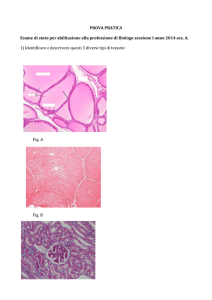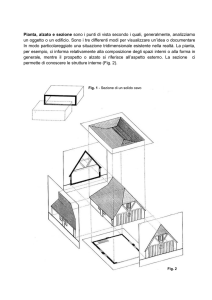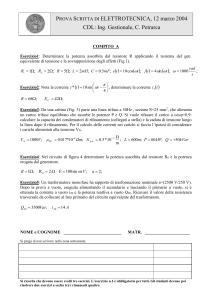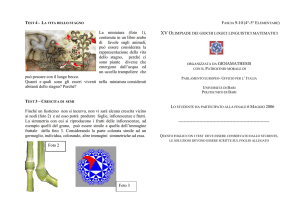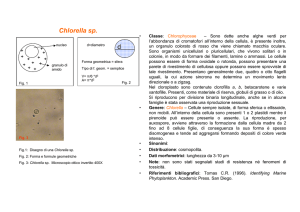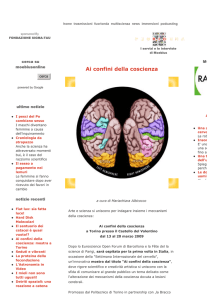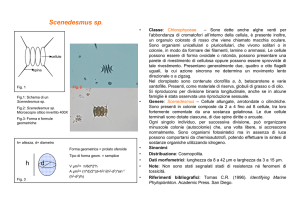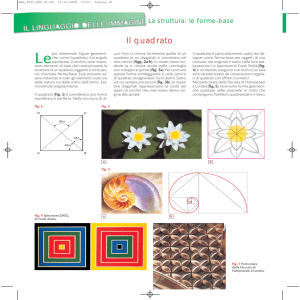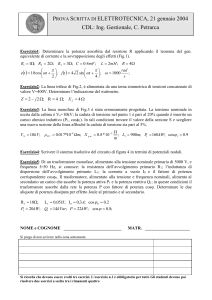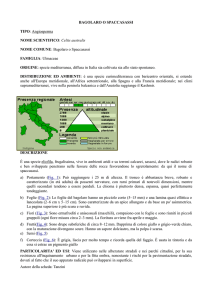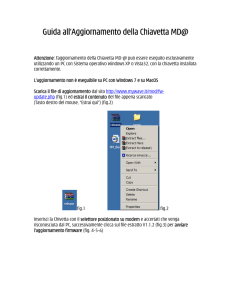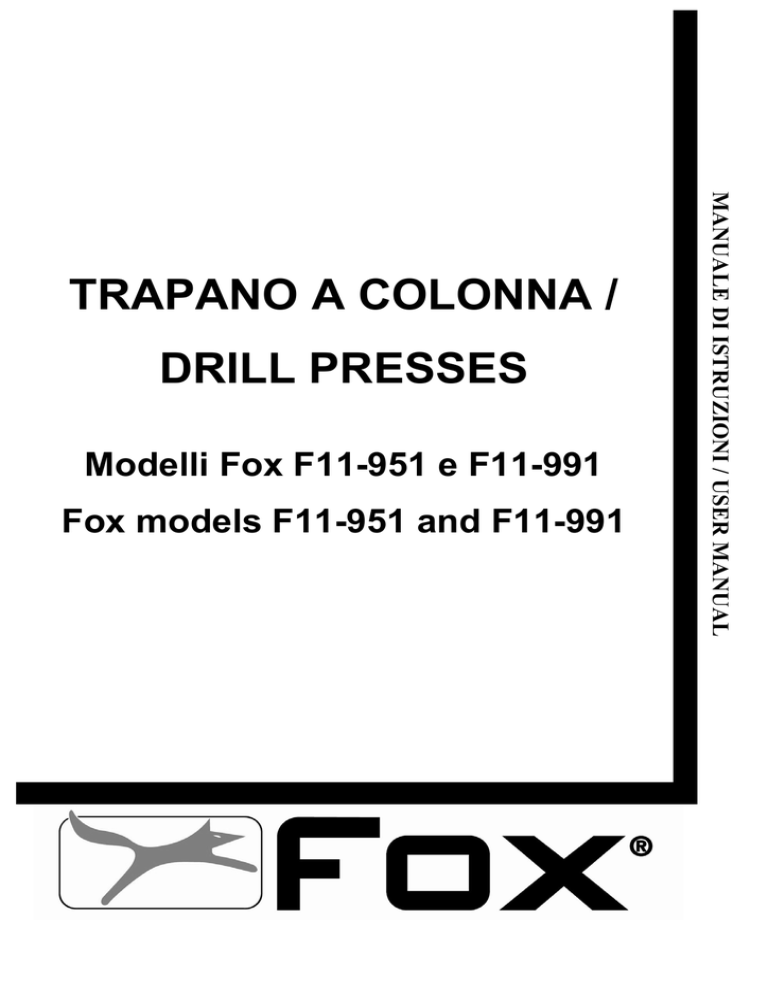
DRILL PRESSES
Modelli Fox F11-951 e F11-991
Fox models F11-951 and F11-991
MANUALE DI ISTRUZIONI / USER MANUAL
TRAPANO A COLONNA /
Fig. 1
1. Testa e motore / Head and motor
2. Colonna e attacco / Column and
connector
3. Base / Base
6
1
4. Piano con leva di bloccaggio /
Workbench and locking lever
7
4
5. Volantino di salita e discesa /
Height adjustment handwheel
5
6. Mandrino / Spindle
10
7. Protezione / Protection
3
8. Chiavi / Wrenches
9. 3 viti, 3 rondelle piane e 3
rondelle di arresto / 3 screws, 3
flat washers and 3 stop washers
2
Fig. 2
10. Morsa / Vice
A
B
Fig. 3
2
O
A
E
B
C
Fig. 4
F 11-951
Fig. 5
B
F
G
A
A
Fig. 6
Fig. 7
M
L
K
M
F 11-951
Fig. 8
Fig. 9
3
A
Fig. 10
Velocità
dell’asse / Axle
speed
F 11-951
Fig. 11
F 11-951
Velocità del
motore /
Motor speed
B
D
A
C
Velocità (giri/min) / Speed (RPM).
Fig. 12
F 11-951
Fig. 13
A
Fig. 14
Fig. 15
4
D
A
B
C
Fig. 16
Fig. 17
A
L
Fig. 18
Fig. 19
C
B
O
A
Fig. 20
Fig. 21
5
Fig. 22 F11-991
Fig. 23
F11-991
Fig. 24 F11-991
6
Fig. 25
Fig. 26
F11-991
Fig. 27
F11-991
Fig. 28
F11-991
7
Fig. 29 F11-991
8
SOMMARIO / INDEX
ITALIANO (IT) Manuale originale, Original manual
10÷27
ENGLISH (EN) Manuale tradotto dall’originale / Manual translated from the original
28÷45
DICHIARAZIONE DI CONFORMITA / DECLARATION OF CONFORMITY
46
ESPLOSO / EXPLODED VIEW
47
SCHEMA ELETTRICO / WIRING DIAGRAM
51
9
Trapani a colonna (Modello FOX F11-951 e F11-991)
SOMMARIO
•
•
•
•
•
•
•
•
•
•
•
•
•
•
•
•
•
•
•
•
•
•
•
•
•
•
Sicurezza
Regole generali di sicurezza
Regole supplementari di sicurezza per i trapani a colonna
Regole di sicurezza per il puntatore laser
Protezione dell’ambiente
Simboli
Collegamento alla corrente elettrica
Uso conforme alle norme
Caratteristiche tecniche
Informazioni sul rumore
Disimballo
Descrizione del trapano a colonna
Assemblaggio del trapano a colonna
Fissaggio del trapano a colonna
Velocità di foratura
Selezione velocità e tensionamento cinghia
Avvio del trapano a colonna
Regolazioni del piano
Regolazione della molla di ritorno del mandrino
Uso del puntatore laser
Regolazione profondità di foratura
Utilizzo punte coniche sul trapano F 11-991
Consigli per l’utilizzo del trapano a colonna
Manutenzione
Anomalie di funzionamento
Assistenza
10
Pag. 10
Pag. 11
Pag. 13
Pag. 14
Pag. 14
Pag. 14
Pag. 15
Pag. 16
Pag. 17
Pag. 18
Pag. 18
Pag. 19
Pag. 19
Pag. 20
Pag. 21
Pag. 21
Pag. 22
Pag. 22
Pag. 22
Pag. 23
Pag. 23
Pag. 23
Pag. 23
Pag. 24
Pag. 25
Pag. 26
SICUREZZA
ATTENZIONE:
Quando si utilizzano utensili elettrici si dovrebbero sempre rispettare, oltre a quelle riportate in
questo manuale, tutte le precauzioni base di sicurezza per ridurre il rischio di incendio, scossa
elettrica e danni personali.
Leggere attentamente tutte queste istruzioni prima di utilizzare questo prodotto e
conservarle scrupolosamente.
Le lavorazioni effettuate con un elettroutensile possono diventare pericolose per l’operatore se
non vengono rispettate norme operative sicure ed adeguate. Come per qualsiasi macchina
elettrica che ha un organo di lavoro in movimento, l’utilizzo dell’utensile comporta alcuni rischi.
Se la macchina viene utilizzata come indicato su questo manuale, prestando la massima
attenzione al lavoro che si sta facendo, rispettando le regole ed utilizzando gli adeguati
dispositivi di protezione individuale, la probabilità di incidenti sarà quasi nulla. I possibili rischi
residui sono relativi a:
1 – contatti diretti od indiretti con la scossa elettrica
2 – ferimenti per contatto con parti rotanti in movimento
3 – ferimenti per contatto con parti spigolose
4 – ferimenti per eiezioni di parti di utensile o di materiale in lavorazione
Le attrezzature di sicurezza previste sulle macchine, come le protezioni, i carter, gli
spingipezzo, i dispositivi di ritenuta, i dispositivi di protezione individuale come gli occhiali, le
maschere antipolvere, le protezioni auricolari, le scarpe e i guanti possono ridurre le probabilità
di incidente. Anche la migliore protezione, però, non può proteggere contro la mancanza di
buon senso e di attenzione. Abbiate sempre buon senso e prendete le precauzioni necessarie.
Fate solo i lavori che ritenete siano sicuri. NON DIMENTICATE: la sicurezza è responsabilità di
ognuno.
Questo utensile è stato concepito per un utilizzo ben preciso. FEMI raccomanda di non
modificarlo o di non utilizzarlo per scopi diversi rispetto a quelli per cui è stato costruito. Se
avete dei dubbi relativamente ad applicazioni specifiche, NON utilizzate l’utensile prima di aver
contattato FEMI e aver ricevuto informazioni in merito.
LEGGETE E CONSERVATE QUESTO MANUALE
11
REGOLE GENERALI DI SICUREZZA
1. Mantenete l’area di lavoro pulita. Nelle zone o nei banchi di lavoro ingombri è più alta
la probabilità di incidenti.
2. Evitate un ambiente pericoloso. Non esponete gli utensili alla pioggia e non utilizzateli
in ambienti umidi o bagnati, per evitare i fenomeni di elettrolocuzione. Mantenete la zona
di lavoro ben illuminata. Non utilizzate l’utensile in presenza di gas o di liquidi
infiammabili.
3. Collegate il dispositivo di aspirazione della polvere. Se sono previsti dei metodi per il
recupero della polvere, assicuratevi che questi dispositivi siano collegati e utilizzati
correttamente.
4. Tenete gli estranei e i bambini lontani. Tutti gli estranei e i bambini devono mantenere
una distanza di sicurezza dall’area di lavoro.
5. Proteggetevi dalle scariche elettriche. Evitate di entrare in contatto con delle superfici di
messa a terra.
6. Non maltrattate il cavo elettrico. Non tirate mai il filo elettrico per scollegarlo dalla
presa. Mantenete il cavo elettrico lontano dal calore, dall’olio e dagli spigoli vivi.
7. Utilizzate delle prolunghe elettriche previste per l’esterno. Quando l’utensile viene
utilizzato all’esterno, utilizzate solamente delle prolunghe elettriche previste per l’esterno
e che riportino delle indicazioni in merito.
8. Siate vigili. Osservate attentamente quello che fate, abbiate buon senso. Non utilizzate
l’utensile quando siete affaticati.
9. Non utilizzate l’utensile se siete sotto l’effetto di medicinale, alcol, droghe.
10. Evitate l’avvio accidentale. Assicuratevi che l’interruttore sia nella posizione di arresto
prima di collegare l’utensile.
11. Indossate una tenuta appropriata. Non indossate vestiti ampi o gioielli che possono
impigliarsi nei pezzi mobili. Per il lavoro all’esterno sono particolarmente raccomandate le
scarpe antiscivolo. Portate un mezzo di protezione per i capelli lunghi.
12. Usate sempre i dispositivi di protezione personale: portate gli occhiali di sicurezza e
mascherine nei casi in cui si producano polveri o trucioli. Indossate cuffie antirumore o
tappi protettivi in ambienti rumorosi. Usate guanti quando si maneggiano particolari con
spigoli vivi e taglienti.
13. Non sbilanciatevi sopra all’utensile. Mantenete sempre il vostro equilibrio.
14. Chiedete consigli a persone esperte e competenti se non avete familiarità con il
funzionamento dell’utensile.
15. Allontanate gli utensili inutilizzati. Quando gli utensili non vengono utilizzati, devono
essere sistemati in un luogo secco, chiuso a chiave, fuori dalla portata dei bambini.
12
16. Non forzate l’utensile. La lavorazione sarà migliore e maggiormente sicura se l’utensile
viene utilizzato al ritmo per il quale è stato concepito.
17. Utilizzate l’utensile appropriato. Non forzate un piccolo utensile a fare il lavoro di un
utensile a utilizzo intensivo.
18. Fissate il pezzo. Utilizzate per quanto possibile dei morsetti a vite o una morsa per
bloccare il pezzo. E’ più sicuro che servirsi delle sole mani.
19. Mantenete gli utensili in perfetto stato. Tenete gli utensili affilati e puliti in modo da
ottenere un rendimento migliore e più sicuro. Seguite le istruzioni per lubrificare e
sostituire gli accessori. Controllate regolarmente il cavo elettrico e sostituitelo se è
danneggiato. Tenete le maniglie e le impugnature secche, pulite e prive di olio e di
grasso.
20. Scollegate l’utensile dalla rete quando non è utilizzato, prima della manutenzione e della
sostituzione degli accessori o utensili quali lame, punte, le frese, ecc.
21. Allontanate le chiavi di serraggio e di regolazione. Prendete l’abitudine di verificare che
le chiavi di serraggio e di regolazione siano state allontanate dall’utensile prima di
avviarlo.
22. Controllate i particolari dell’utensile per verificare che non ci siano parti danneggiate.
Prima di continuare ad utilizzare l’utensile, controllate tutti i dispositivi di sicurezza o
qualsiasi altro pezzo che possa essere danneggiato in modo da assicurarvi che funzioni
bene e che riesca ad effettuare il compito previsto. Verificate che i pezzi mobili siano ben
allineati, non si blocchino e non siano rotti. Controllate anche il montaggio o qualsiasi
altra condizione che può influenzare il funzionamento. Qualsiasi pezzo o qualsiasi
protezione danneggiata deve essere riparata o sostituita da un centro di servizio postvendita autorizzato. Non utilizzate l’utensile se l’interruttore non funziona correttamente.
23. Utilizzate l’elettroutensile, gli utensili e gli accessori nel modo e per gli scopi riportati in
questo manuale; utilizzi e componenti diversi possono generare possibili rischi per
l’operatore.
24. Fate riparare l’utensile da una persona competente. Questo utensile elettrico è
conforme alle prescrizioni di sicurezza corrispondenti. Le riparazioni devono essere
realizzate solo da persone qualificate che utilizzino ricambi originali, altrimenti potrebbero
insorgere dei pericoli per l’utilizzatore.
13
REGOLE DI SICUREZZA SUPPLEMENTARI PER I TRAPANI A COLONNA
1.
NON UTILIZZATE il trapano finché non è completamente assemblato e installato secondo
le direttive del presente manuale.
2.
FISSATE il trapano a colonna su un supporto o su un piano. Se il supporto o il piano si
spostano durante l’utilizzo, FISSATELI al pavimento.
3.
AVVIATE il trapano solo dopo aver tolto qualsiasi oggetto (utensili, pezzi di scarto, ecc.).
4.
NON AVVIATE il trapano a colonna quando la punta si trova contro il pezzo da lavorare.
5.
UTILIZZATE SOLAMENTE delle punte, degli utensili o altri accessori dotati di un perno di
attacco al mandrino inferiore a 13mm per il modello F11-951 e inferiore a 16 per il F11991.
6.
MANTENETE sempre le mani e le dita lontani dalla punta o dall’utensile.
7.
EVITATE le posizioni delle mani scomode che potrebbero provocare uno scivolamento
sull’utensile
8.
NON TENTATE di forare un pezzo di materiale che non abbia una superficie piatta, a
meno che non utilizziate un piano di appoggio adeguato.
9.
UTILIZZATE sempre un sistema di bloccaggio per evitare pericolose rotazioni del pezzo in
lavoro.
10. UTILIZZATE le velocità raccomandate per forare i vari materiali in funzione della punta
usata.
11. ASSICURATEVI che tutti i pomelli di blocco siano stretti prima di avviare l’utensile e che la
protezione trasparente del mandrino sia in posizione.
12. NON ESEGUITE mai degli assemblaggi, dei montaggi o delle preparazioni sul piano
quando il trapano funziona.
13. ASSICURATEVI che la punta o l’utensile non siano danneggiati e che siano
adeguatamente bloccati nel mandrino prima dell’utilizzo.
14. ASSICURATEVI che la chiave del mandrino sia stata tolta dal mandrino prima di avviare il
trapano. Utilizzate SOLAMENTE la chiave del mandrino fornita con il trapano a colonna.
15. REGOLATE l’altezza del piano di lavoro e la profondità di discesa della punta per evitare
di forare il piano.
16. ARRESTATE SEMPRE il trapano prima di eliminare i trucioli dal piano di foratura
17. ASSICURATEVI che i pezzi grandi in lavoro siano adeguatamente sostenuti all’altezza del
piano durante il taglio.
18. SCOLLEGATE LA CORRENTE, togliete la punta o l’utensile e pulite il piano prima di
allontanarsi dalla macchina.
19.
SOSTITUITE i pezzi mancanti o danneggiati. Non utilizzate il trapano se non è
perfettamente funzionante in tutte le sue parti.
14
REGOLE DI SICUREZZA PER IL PUNTATORE LASER
•
•
•
•
•
•
•
Non guardate mai in direzione del puntatore laser.
Non orientate il laser verso persone o animali.
Non utilizzate il puntatore laser su materiali molto riflettenti. La luce riflessa è tanto
pericolosa quanto quella diretta.
Fate riparare il puntatore laser solamente da tecnici qualificati.
Non toccate la lente del laser con degli oggetti duri.
Pulite la lente del laser tramite un pennello morbido.
L’eventuale sostituzione del puntatore va fatta con uno dello stesso tipo
PROTEZIONE DELL’AMBIENTE
INFORMAZIONE AGLI UTENTI
Ai sensi dell’art. 13 del Decreto Legislativo 25 luglio 2005, n. 151 “Attuazione delle Direttive
2002/95/CE, 2002/96/CE, e 2003/108/CE, relative alla riduzione dell’uso di sostanze pericolose
nelle apparecchiature elettriche ed elettroniche, nonché allo smaltimento dei rifiuti”, si precisa
quanto segue:
• Il simbolo del cassonetto barrato riportato sull’apparecchiatura o sulla confezione indica
che il prodotto alla fine della propria vita utile deve essere raccolto separatamente dagli
altri rifiuti.
• L’utente dovrà, pertanto, conferire l’apparecchiatura giunta a fine vita agli idonei centri di
raccolta differenziata dei rifiuti elettronici ed elettrotecnici, oppure riconsegnarla al
rivenditore al momento dell’ acquisto di una nuova apparecchiatura di tipo equivalente, in
ragione di uno ad uno.
• L’adeguata raccolta differenziata per l’avvio successivo dell’apparecchiatura dismessa al
riciclaggio, al trattamento ed allo smaltimento ambientalmente compatibile, contribuisce
ad evitare possibili effetti negativi sull’ambiente e sulla salute e favorisce il reimpiego e/o
riciclo dei materiali di cui è composta l’apparecchiatura.
ATTENZIONE!
Lo smaltimento abusivo del prodotto da parte dell’utente comporta l’applicazione delle
sanzioni amministrative previste dalla normativa vigente.
SIMBOLI
Leggere attentamente il manuale di istruzioni
Utilizzare dispositivi individuali di protezione (occhiali, maschera
antipolvere e cuffie.
15
E’ vietato inserire le mani in questa zona, utensile in funzione. Pericolo di
trascinamento/taglio.
Indica il servizio sull’ utensile di un puntatore laser (vedi paragrafo REGOLE
DI SICUREZZA PER IL PUNTATORE LASER).
Matricola/anno costruzione
COLLEGAMENTO DELL’UTENSILE ALLA CORRENTE
ALLACCIAMENTO ELETTRICO
Per l’alimentazione della vostra macchina è necessaria una tensione alternata a 230 V 50 Hz
con conduttore di terra. Assicuratevi che la vostra alimentazione abbia queste caratteristiche,
che sia protetta da un interruttore differenziale e magnetotermico e che l’impianto di terra sia
efficiente. Se la vostra macchina non funziona quando è collegata ad una presa, verificate
attentamente le caratteristiche dell’alimentazione.
ISTRUZIONI PER LA MESSA A TERRA
Presa di corrente con
terra
Conduttore di terra
Presa della
macchina
In caso di cattivo funzionamento o di corto circuito dell’utensile, la messa a terra fornisce un
cammino di minore resistenza alla corrente elettrica e riduce il rischio di scarica elettrica.
Questo utensile è dotato di un cavo elettrico che possiede un conduttore di messa a terra e una
spina con il contatto di terra. La spina deve essere collegata ad una presa corrispondente
correttamente installata e messa a terra in conformità alle normative e disposizioni locali.
Assicuratevi della bontà del vostro impianto di terra e che la vostra presa sia protetta a monte
da un interruttore differenziale e magnetotermico.
Non modificate la spina fornita. Se non entra nella presa, fate installare una presa appropriata
da un elettricista qualificato. Un collegamento mal fatto del conduttore della messa a terra
dell’attrezzo può comportare il rischio di scarica elettrica. Il conduttore la cui guaina isolante è
verde con o senza linea gialla è il conduttore della messa a terra. Se risulta necessaria la
16
riparazione o la sostituzione del cavo di alimentazione, non collegate il conduttore di terra ad un
morsetto sotto tensione.
Informatevi presso un elettricista qualificato o da una persona responsabile della manutenzione
se non avete compreso o avete qualche dubbio sulle istruzioni della messa a terra.
Se il cavo di alimentazione è danneggiato deve essere sostituito da centri assistenza autorizzati
o da personale qualificato. Non fate funzionare l’utensile se il cavo di alimentazione è
danneggiato.
Questo utensile è dotato di una spina che deve essere collegata ad una presa adeguata.
PROLUNGHE ELETTRICHE
Utilizzate solamente delle prolunghe elettriche a tre conduttori che possiedono una spina a due
spinotti e contatto di terra e delle prese a due cavità e una terra corrispondente alla spina
dell’utensile Quando utilizzate un utensile elettrico ad una distanza considerevole
dall’alimentazione, assicuratevi di utilizzare una prolunga di dimensioni sufficienti per
trasportare la corrente di cui l’utensile ha bisogno. Una prolunga sotto dimensionata
provocherebbe una caduta di tensione elevata nella linea, con perdita di potenza e
conseguente surriscaldamento del motore. Possono essere utilizzate solamente delle
prolunghe conformi alle norme CE.
Lunghezza della prolunga elettrica: fino a 15 m
Dimensioni del cavo: 3 x 2,5 mm²
Prima di utilizzare qualsiasi prolunga, verificate che non abbia dei fili scoperti e che l’isolante
non sia tagliato o usurato. Riparate o sostituite immediatamente la prolunga danneggiata o
usurata.
ATTENZIONE:
Le prolunghe devono essere sistemate fuori dalla zona di lavoro per evitare che possano
entrare in contatto con i pezzi in lavoro, l’utensile o altri particolari della macchina e creare
possibili rischi.
ATTENZIONE:
TENETE GLI UTENSILI E LE ATTREZZATURE FUORI DALLA PORTATA DEI BAMBINI
USO CONFORME ALLE NORME
Questo utensile è stato progettato e costruito per eseguire delle forature su acciaio, metalli in
genere, legno, plastica e in genere tutti i tipi di materiali, ad eccezione di acciaio temprato,
utilizzando punte appropriate e selezionando le velocità adeguate al materiale da tagliare e
all’utensile che si sta impiegando.
La massima capacità di foratura su acciaio è di 13 mm per F11-951 e 16 mm per F11-991.
17
CARATTERISTICHE TECNICHE
1. Collegamenti elettrici
Motore
2. Capacità di foratura
Capacità di foratura nell’acciaio
(mm)
Distanza mandrino - colonna (mm)
3. Cono morse
Corsa manicotto (mm)
Cono morse
4. Foratura del piano
Inclinazione del piano
Rotazione del piano sulla base
Dimensioni del piano (mm)
Dimensioni del piano con estensioni
(mm)
Capacità del mandrino – piano di
foratura (mm)
Distanza tra le scanalature (mm)
5. Misure
Altezza (mm)
Profondità (mm)
Larghezza (mm)
Peso totale (kg)
Diametro del manicotto
Distanza max tra il cono morse e il
piano di foratura
6. Area di lavoro necessaria
Altezza (mm)
Profondità (mm)
Larghezza (mm)
7. Velocità di foratura
Velocità di rotazione del mandrino
(giri/min.)
8.Puntatore laser
Classe
Potenza
Lunghezza d’onda laser
9.Vibrazioni
Livello misurato
10. Condizioni di lavoro
Temperatura
Margine di umidità nell’aria
F 11-951
230 V / 50Hz / 350 W
F 11-951
F 11-991
230 V / 50 Hz / 500 W
F 11-991
13
16
102
F 11-951
50
MK 2
F 11-951
45°
360°
195 x 170
126
F 11-991
60
MK 2
F 11-991
45°
360°
240 x 200
280 x 170
330 x 200
13
16
105
F 11-951
730
410
240
30
50
F 11-991
850
520
300
43
60
300
400
F 11-951
2000
1800
1200
F 11-951
580
850
1220
1650
2650
F 11-951
2
< 1 mW
650 nm
F 11-951
< 2,5 m/sec2
F 11-951
F 11-991
2000
1900
1200
F 11-991
425 – 560 – 645
730 - 790 – 860
1275 – 1350 – 1600
1710 – 2060 - 2545
F 11-991
2
< 1 mW
650 nm
F 11-991
< 2,5 m/sec2
F 11-991
5-35° C
25-80%
18
INFORMAZIONI SUL RUMORE
Il rumore emesso e misurato conformemente alle norme EN 3744 e EN 11201 è risultato
essere:
- Livello di pressione acustica LpA = 64,9 dB(A)
- Livello di potenza sonora
LWA = 77,9 dB(A)
- Incertezza della misura K = 3
I valori indicati per il rumore sono livelli di emissione e non necessariamente livelli di lavoro
sicuro. Mentre vi è una correlazione tra livelli di emissione e livelli di esposizione, questa non
può essere usata affidabilmente per determinare se siano richieste o no ulteriori precauzioni. I
fattori che influenzano il reale livello di esposizione del lavoratore includono la durata
dell’esposizione, le caratteristiche dell’ambiente, altre sorgenti di rumore, per esempio il numero
di macchine e altre lavorazioni adiacenti. Inoltre i livelli di esposizione possono variare da un
Paese a Paese. Queste informazioni mettono comunque in grado l’utilizzatore della macchina di
fare la miglior valutazione dei pericoli e dei rischi.
L’emissione del rumore del trapano è molto bassa e quindi non pericolosa per l’operatore, ma in
presenza di altri utensili in funzione o di un ambiente rumoroso potrebbe essere necessario
l’utilizzo di protezioni acustiche.
DISIMBALLO
TRAPANO A COLONNA F11-951 e F11-991
Il vostro nuovo trapano a colonna è consegnato completo dentro ad un cartone. Sballatelo con
cura e verificate che non manchi nulla e che non ci sia niente di danneggiato.
Nel caso fossero presenti parti difettose o rovinate non utilizzarle per non compromettere
l’efficienza e la sicurezza dell’utensile. Rivolgersi ad un centro assistenza autorizzato per la
sostituzione dei particolari difettosi.
Per rendere perfettamente funzionante il trapano devono essere montati vari particolari, per i
quali viene data una dettagliata spiegazione nel seguito.
Si consiglia di leggere attentamente le istruzioni di montaggio e di seguirle alla lettere.
TRAPANO A COLONNA F11-951
La Fig. 1 mostra il trapano a colonna F11-951 completamente montato e la Fig. 2 tutti i pezzi di
contenuti nell’imballo.
TRAPANO A COLONNA F11-991
Il trapano a colonna F11-991 è dotato di un piano montato su cremagliera e di un mandrino
montato su un cono morse indipendente.
La Fig. 1 mostra il trapano finito, la Fig. 2 i componenti base e la Fig. 22 gli ulteriori particolari:
10 Manovella di salita e discesa
11 Cono morse MK2 per fissare il mandrino
12 Mandrino per cono morse MK
13 Chiave di estrazione del cono morse
14 15 Anelli di supporto della cremagliera
16 Cremagliera di salita e discesa del piano
19
DESCRIZIONE DEL TRAPANO A COLONNA
Riferirsi alla Fig. 1 e alla relativa legenda per la rappresentazione e denominazione di tutti i
componenti del trapano.
ASSEMBLAGGIO DEL TRAPANO A COLONNA
AVVERTENZA: PER LA VOSTRA SICUREZZA, COLLEGATE IL TRAPANO ALLA RETE E
FATELO FUNZIONARE SOLO DOPO AVER LETTO ATTENTAMENTE IL MANUALE E
AVERLO ASSEMBLATO COMPLETAMENTE.
PULIZIA
Prima del montaggio conviene eliminare il rivestimento che protegge dalla corrosione le parti
metalliche lavorate. Questo rivestimento può essere rimosso con uno straccio e un po’ di
gasolio o kerosene. NON utilizzate l’acetone, la benzina o solventi all’acqua.
TRAPANO A COLONNA F11-951
1. Montate la colonna (A) fig. 3, alla base (B), come illustrato nella figura, tramite tre viti a
testa esagonale da 20 mm di lunghezza (C) fig. 4.
2. Montate il piano (O) fig. 5, sul trapano a colonna (A), facendo scivolare il piano sulla
colonna come illustrato nelle figura.
3. Avvitate la leva di bloccaggio del piano (E) fig. 5 nei fori dietro al supporto del piano,
come illustrato nella figura. Allineate il piano (O) allo base (B) e stringete la leva di
bloccaggio del piano (E).
4. Posizionate la testa del trapano a colonna (F) fig. 6, sulla colonna (A) abbassandola più
che potete. Dopo aver allineato con il piano e la base, stringete le due viti (G) con la
chiave fornita.
5. Posizionate il volantino (A) sul pignone fig. 7 e stringete la vite di bloccaggio (B) con la
chiave per vite ad esagono incassato come illustrato nelle figura.
6. IMPORTANTE: La portata conica dell’albero mandrino (K) fig. 8, e il foro conico (L) del
mandrino (M) sono ricoperti da una protezione contro la corrosione trasparente che può
essere eliminata con un solvente. Queste superfici devono essere pulite in modo che il
mandrino aderisca bene all’albero e resti fissato durante l’utilizzo. AVVERTENZA: per
togliere il protettivo si può usare un normale detergente domestico, con l’avvertenza di
seguire le istruzioni di uso del prodotto. Successivamente montate il mandrino (M)
sull’albero (K) con un colpo secco.
8. IMPORTANTE: Aprite completamente le ganasce del mandrino ruotando l’anello del
mandrino (M) fig. 9.
9. Tenete il mandrino con attenzione sull’albero e bloccatelo, battendolo con un pezzo di
legno e un martello, o con un mazzuolo come illustrato nella fig. 9.
10. IMPORTANTE: per evitare di danneggiare il mandrino, NON UTILIZZATE mai un
martello di metallo per installarlo.
11. La cinghia è installata prima della spedizione del trapano a colonna, ma si deve
comunque controllare la tirata (vedere paragrafo “Cambiamento delle velocità e
regolazione della tensione della lama”).
20
TRAPANO A COLONNA F11-991
1. Montate la colonna (A) fig. 3, alla base (B), come illustrato nella figura, tramite tre viti a
testa esagonale da 20 mm di lunghezza (C) fig. 4.
2. Fate scivolare l’anello inferiore lungo la colonna (A) fig. 26, poi bloccate l’anello
stringendo la vite a testa esagonale (B). Posizionate questo anello in modo che lo
smusso dell’anello sia visibile sopra.
3. Infilate la cremagliera nel supporto del piano (C) in modo che i denti del pignone siano a
contatto con i denti della cremagliera (A) fig. 23
4. Fate scivolare il supporto del piano con il piano lungo la colonna fino a che l’estremità
conica della cremagliera entri nello smusso dell’anello inferiore.
5. Posizionate l’anello superiore (A) sulla colonna, in modo che il bordo interno dell’anello
blocchi il bordo superiore della cremagliera. Stringete la vite con esagono incassato (B)
per bloccare l’anello superiore fig. 25.
6. Posizionate la testa del trapano a colonna (F) fig. 6, sulla colonna (A) abbassandolo più
che potete. Dopo aver allineato la testa con il piano e la base, stringete le due viti (G) con
la chiave fornita.
7. Posizionate il volantino sul pignone fig. 7 e stringete la vite di bloccaggio, con la chiave
per vite ad esagono incassato, per bloccare la manopola.
8. IMPORTANTE: L’albero porta mandrino fornito separatamente (vedi fig. 24) il foro del
mandrino e il foro dell’albero nella testa, sono ricoperti da una protezione trasparente
contro la corrosione che può essere eliminata con un solvente. Queste superfici devono
essere pulite in modo che il mandrino aderisca bene all’albero e resti fissato durante
l’utilizzo. AVVERTENZA: per togliere il protettivo si può usare un normale detergente
domestico, con l’avvertenza di seguire le istruzioni di uso del prodotto. Successivamente
montate il mandrino (B) sull’albero (A) con un colpo secco e quindi, con la stessa tecnica,
posizionate il gruppo albero-mandrino sul foro conico nella testa del trapano.
9. IMPORTANTE: Aprite le ganasce del mandrino al livello massimo ruotando l’anello del
mandrino (M) fig. 9.
10. Tenete il mandrino con attenzione e bloccatelo, battendolo con un pezzo di legno e un
martello, o con un mazzuolo come illustrato nella fig. 9.
11. IMPORTANTE: Per evitare di danneggiare il mandrino, NON utilizzate un martello di
metallo per installarlo.
.
FISSAGGIO DEL TRAPANO A COLONNA
Il trapano è dotato di una base che garantisce una buona stabilità, ma ha anche la possibilità di
essere fissato ad un banco. con 4 viti nei fori (A) della fig. 10.
Si consiglia di fissarlo al banco di lavoro con 4 viti utilizzando i fori (A) della fig.10 della base per
eliminare possibili rischi.
21
VELOCITÀ DI FORATURA
I fattori che determinano un miglior regime di lavoro con i trapani a colonna sono il tipo di
materiale, la grandezza del foro, il tipo di punta o di fresa e la qualità del taglio desiderata. Più
la punta è piccola, più la velocità necessaria deve essere alta. La velocità deve essere più alta
nei materiali teneri che nei metalli duri. Utilizzate la velocità raccomandata per la punta e il
materiale da forare.
TRAPANO A COLONNA F11-951
Il mandrino di questo trapano può ruotare a 5 velocità diverse: 580, 850,1220, 1650 e 2650
giri/min. La velocità più lenta si ottiene con la cinghia sul gradino più piccolo della puleggia del
motore e sul gradino più grande della puleggia del mandrino, come illustrato nelle figura 11. La
figura 12 illustra la disposizione della cinghia sui differenti gradini delle pulegge necessaria per
ottenere le cinque diverse velocità.
TRAPANO A COLONNA F11-991
Il mandrino di questo trapano a colonna può ruotare a 12 velocità diverse: 425, 560, 645, 730,
790, 860, 1275, 1350, 1600, 1710, 2060, 2545 giri/min. La figura 29 illustra la disposizione delle
cinghie sui diversi gradini delle pulegge, per ottenere le dodici diverse velocità. In questo caso
oltre alla puleggia motore e quella del mandrino è presente una terza puleggia intermedia.
SELEZIONE VELOCITÀ E TENSIONAMENTO DELLA CINGHIA
1. Spegnete il trapano a colonna e scollegatelo all’alimentazione.
2. Svitate la vite di chiusura della scatola di protezione delle cinghie (A) aprite il coperchio
(B) fig. 13.
3. Allentate la cinghia svitando il pomello di chiusura della tensione (C) fig. 13, per F11991 sono due, e spingete il motore verso la parte anteriore del trapano.
TRAPANO A COLONNA F11-951
4. Per il trapano F11-951 posizionate la cinghia (D) sulle gole delle pulegge del mandrino e
del motore che corrispondono alla velocità desiderata, come illustrato nella fig. 13.
TRAPANO A COLONNA F11-991
5. Per il trapano a colonna F11-991 posizionate le due cinghie in funzione della velocità
desiderata. La figura 29 indica le combinazioni di velocità possibili in funzione della
posizione delle due cinghie.
6. Dopo aver posizionato le cinghie sulle pulegge, spingete il motore verso la parte
posteriore fino a che non siano ben tese, poi stringete il pomello di bloccaggio della
tensione (C) fig. 13 o i due nel caso di F11-991. Le cinghie devono essere tese
abbastanza per evitare il pattinamento. Una tensione troppo forte ridurrebbe la durata
della cinghia, delle pulegge e dei cuscinetti. La tensione è corretta quando la cinghia (D)
può essere flessa con il dito di circa 2,5 cm dalla sua posizione normale tra le pulegge.
7. Richiudete il coperchio e fissatelo con la sua vite. Se il coperchio non è chiuso il trapano
non parte, perché non viene azionato il micro di sicurezza che si trova sotto il coperchio.
22
AVVIO DEL TRAPANO A COLONNA
L’interruttore (A) fig. 14 è situato sulla sinistra della testa del trapano a colonna. Per avviare il
trapano, premete il pulsante verde dell’interruttore marcato « I » (AVVIO); per arrestarlo,
premete sul pulsante rosso dell’interruttore marcato «O» (ARRESTO).
L’interruttore utilizzato su questo utensile è del tipo a “minima tensione“ ed impedisce il
riavviamento automatico del trapano in caso di ripristino dell’energia elettrica dopo
un’interruzione; quindi quando si verificano interruzioni di energia elettrica il trapano si ferma e
per farlo ripartire si deve premere nuovamente il pulsante verde.
REGOLAZIONE DEL PIANO
TRAPANO A COLONNA F11-951
Il piano di lavoro del trapano F11-951 può essere spostato in altezza o ruotato dietro la colonna
allentando la leva di blocco del piano (A) fig. 15. Spostate il piano sulla colonna nella posizione
desiderata e stringete la leva di bloccaggio del piano (A).
TRAPANO A COLONNA F11-991
Il piano di lavoro del trapano a colonna F11-991 può essere spostato in altezza o spostato
dietro la colonna; allentare la leva di bloccaggio poi ruotare la manovella per alzarlo o
abbassarlo e bloccare la leva; per spostarlo dietro, allentare la leva, spostare manualmente il
piano dietro e bloccare la leva.
Il piano può anche essere inclinato verso destra o sinistra svitando il bullone di bloccaggio fig.
16 situato sotto il piano con una chiave da 19 mm. Una targhetta graduata sul supporto di
fissaggio del piano e un indice sul piano permettono di conoscere l’angolo di inclinazione del
piano. Inclinato; posizionate il piano all’angolo desiderato e stringete il bullone.
REGOLAZIONE DELLA MOLLA DI RITORNO DEL MANDRINO
Una molla di ritorno situata nella scatola (A) fig. 17 assicura il ritorno automatico del mandrino
verso l’alto dopo aver terminato la foratura. Questa molla è stata regolata durante il montaggio
e non dovrebbe essere toccata. Nell’eventualità di doverla registrare, procedete come
specificato di seguito:
1. Spegnete il trapano a colonna e scollegatelo all’alimentazione.
2. Allentate i due dadi (B) fig. 17, di circa 6 mm. Non levate questi dadi (B) dall’albero (C).
3. Tenendo ben stretta la scatola della molla (A) fig. 17, tiratela in fuori e ruotatela fino a che
la linguetta (D) non si adatti al dente successivo della scatola. Ruotate la scatola verso
sinistra per aumentare la tensione della molla e verso destra per ridurla. Stringete infine i
due dadi (B) che mantengono la scatola nella sua posizione. IMPORTANTE: Il dado
interno (B), dopo essere stato stretto, non deve entrare in contatto con la scatola della
molla (A).
23
USO DEL PUNTATORE LASER
La vostra macchina è dotata di un puntatore laser che permette di indicare il centro della
foratura sul materiale da lavorare; questa regolazione va fatta per un determinato spessore del
legno e per un’altezza del piano di lavoro fig. 18.
Spostando il piano di appoggio o cambiando lo spessore del legno da forare si deve ripetere la
messa a punto.
1. Posizionate e fissate il legno da forare sul piano o nella morsa
2. Accendente il puntatore laser premendo sull’interruttore (C) fig. 20.
3. Fate scendere la punta fino ad eseguire un piccolo centro sul pezzo
4. Spostate il puntatore laser (L) fig. 18 in modo che la croce sia centrata esattamente sul
centrino fatto dalla punta, regolando il raggio (A) fig. 19. Qualsiasi spostamento del piano
o cambiamento di spessore del legno comporta una modifica della centratura del raggio
laser e rende necessaria una nuova regolazione.
REGOLAZIONE DELLA PROFONDITA’ DI FORATURA
Dovendo effettuare numerosi fori alla stessa profondità conviene regolare il trapano, usando la
rotella di profondità (A) fig. 20.
1. Ruotando la rotella (A) si sposta il fermo (O) che è il punto di fermo e di massima
discesa della punta; su questo fermo si blocca il riferimento (B) che si muove nel corso
dell’avanzamento di foratura. Muovete la rotella per selezionare la profondità di foratura
desiderata.
2. Fate un foro di prova e controllate la profondità ottenuta. Rifate la regolazione se risulta
necessario. In questo modo tutti i fori che farete, su particolari dello stesso spessore,
avranno la stessa profondità.
UTILIZZO DI PUNTE CONICHE SUL TRAPANO F11-991
Il trapano a colonna F11-991 ha il mandrino da 16 mm montato sull’albero conico (A) di fig. 24,
che può essere levato, con la chiave 13 di fig. 22, in dotazione, per permettere l’utilizzo delle
punte con codolo conico..
Per togliere il gruppo albero-mandrino abbassatelo con il volantino di discesa-salita, per avere
accesso al foro di espulsione del cono morse.
Inserite la chiave, come illustrato in fig.28 e spingetela all’interno con un martello, stando attenti
a non far cadere il mandrino.
Introducete la punta conica nell’estremità dell’albero cavo.
Per estrarre la punta utilizzate sempre la chiave fornita, seguendo lo stesso procedimento.
CONSIGLI PER L’UTILIZZO DEL TRAPANO A COLONNA
AVVERTENZA: L’utilizzo di accessori non raccomandati da Delta France può comportare
il rischio di incidenti.
Le seguenti istruzioni forniscono al principiante indicazioni generali sull’uso del un trapano a
colonna.
• Prima di intraprendere il lavoro, fate delle prove su dei ritagli o pezzi di scarto per
prendere familiarità.
• Avvicinate lentamente la punta al pezzo da forare.
• Regolate la profondità di foratura per evitare di forare il piano di appoggio.
24
•
IMPORTANTE: Quando il pezzo da forare è abbastanza lungo deve essere posizionato
sul piano, con una delle estremità contro la colonna, come illustrato nelle fig. 21 e
fissato con dei morsetti o bloccato con una morsa.
FORATURA DEI METALLI
Selezionate la velocità raccomandata per la punta che state usando, come tipo e diametro, e il
materiale da forare.
Utilizzate una morsa per mantenere il pezzo da forare nella sua posizione. Non bisogna mai
tenerlo con le mani nude; i bordi taglienti della punta possono trascinare il pezzo in qualsiasi
momento e soprattutto nel momento di uscita dal pezzo. L’operatore potrebbe rimanere ferito
dal pezzo strappato dalla sua mano. In più, la punta potrebbe rompersi nel momento in cui il
pezzo da forare colpisce la colonna.
Il pezzo da forare deve essere bloccato adeguatamente durante la foratura, in quanto
qualunque attorcigliamento, inclinazione o spostamento, oltre a realizzare un foro irregolare,
aumenta la possibilità di rottura della punta. Per forare dei pezzi piani, posizionateli su una
base in legno e bloccateli in modo efficace sul piano per impedirne la rotazione. Sistemate e
bloccate accuratamente anche i pezzi di forma irregolare che presentano maggiori difficoltà di
foratura.
FORATURA DEL LEGNO
Selezionate la velocità raccomandata per la punta che state usando, come tipo e diametro, e il
materiale da forare.
Le punte normali a spirale previste per la foratura dei metalli, possono essere utilizzate anche
per forare il legno; per la lavorazione del legno sono comunque da preferire le mecchie, che
sono punte specifiche per il legno. Queste punte fanno un foro con il fondo piano e non
inclinato come quelli realizzate con punte da metallo e hanno anche una buona evacuazione
dei trucioli. Non montate le punte il cui utilizzo è previsto a mano, perchè dotate di un’elica che,
se usate sul trapano a colonna, farebbero sollevare il pezzo da lavorare dal piano, creando
pericolo per l’operatore.
Per una foratura passante, allineate il piano in modo che la punta penetri nel foro centrale del
piano di appoggio. Fate una linea di riferimento verticale sul fronte della colonna e un punto di
riferimento corrispondente nel supporto del piano, in modo che il piano possa essere bloccato
nella posizione centrale a qualsiasi altezza.
Abbassate lentamente il mandrino quando la punta sta per attraversare il legno, per impedire il
danneggiamento del lato inferiore del pezzo. Utilizzate un ritaglio da posizionare sotto il pezzo
da forare per ridurre i trucioli e proteggere l’estremità della punta.
MANUTENZIONE
AVVERTENZA: Spegnete l’interruttore e scollegate il trapano dalla corrente, togliendo la spina
del cavo dalla presa di corrente prima di qualsiasi regolazione, riparazione, manutenzione o
sostituzione della punta.
Qualsiasi danneggiamento delle protezioni, o anomalia riscontrata nel funzionamento o nel
corso del controllo del trapano deve essere riparato immediatamente da personale qualificato
per quel tipo di intervento.
Prima di ogni utilizzo verificate che le protezioni e le sicurezze siano perfettamente efficienti e al
termine del lavoro fare una pulizia generale della macchina, eliminando polvere e trucioli.
Mantenere la protezione del mandrino sempre perfettamente funzionante.
25
Mantenere scorrevole l’albero porta mandrino pulendolo e lubrificandolo periodicamente, come
pure la colonna.
Pulire periodicamente le aperture di ventilazione del motore.
Verificare periodicamente l’integrità del cavo di alimentazione.
Verificare periodicamente la tirata della cinghia.
ANOMALIE DI FUNZIONAMENTO
Il trapano non parte:
Mancanza di corrente nella presa in cui è inserito il cavo di alimentazione
Cavo di alimentazione difettoso
Motore in avaria
Coperchio della scatola puleggia non chiuso
Usura rapida degli utensili:
Utensile non adeguatamente affilato
Utensile non adatto o, nella foratura di metalli, mancanza di lubrorefrigerante
Utilizzo di un avanzamento eccessivo
Funzionamento anomalo del motore:
Possibile avaria del motore; fare controllare da un elettricista
Salita - discesa dell’albero difficoltosa:
Pulire e ingrassare l’albero porta mandrino sotto la puleggia.
26
ASSISTENZA
Tutti gli utensili e accessori Fox sono costruiti e controllati utilizzando le più moderne e sicure
tecniche produttive. Se nonostante queste attenzioni un utensile dovesse guastarsi la
riparazione deve essere fatta da un centro riparazioni autorizzato FEMI.
L’elenco dei centri assistenza è reperibile presso i vari punti vendita o telefonando al numero
051/6946469 o inviando una richiesta all’ indirizzo di posta elettronica [email protected].
27
Drill presses (FOX models F11-951 and F11-991)
INDEX
•
•
•
•
•
•
•
•
•
•
•
•
•
•
•
•
•
•
•
•
•
•
•
•
•
Safety instructions
General safety instructions
Specific safety instructions for drill presses
Safety instructions for the laser pointing device
Environment protection
Symbols
Electrical connections
Recommended use
Technical specifications
Noise conditions
Removal of package
Drill press description
Drill press assembly
Drill press fixing
Drilling speed
Speed selection and belt tensioning
Starting the drill press
Workbench adjustments
Adjustment of spindle’s return spring
Use of the pointing device
Adjustment of drilling depth
Use of cone bits on model F11-991
Advices for using the drill press
Maintenance
Malfunctions
After-sales service
28
29
30
32
33
33
33
34
35
36
37
37
38
38
39
40
40
41
41
41
42
42
42
42
43
44
45
SAFETY INSTRUCTIONS
CAUTION:
Besides following the instructions mentioned in this manual, when using electric equipment you
must always observe all safety precautions to prevent risk of fire, electric shock and personal
injury.
Read this instruction manual before use and keep it carefully.
Working with an electric machine can be dangerous if you do not follow suitable safety
measures. As for any electric machine with moving parts, the use of a tool entails some risks. If
you use the machine as prescribed in this manual, you pay careful attention to the work you are
doing, you observe the regulations and you use the suitable personal devices of protection, you
can reduce the probability of risk. The possible remaining risks are related to:
1 – direct or in direct contacts with electrical shock
2 – injuries due to contact with moving parts
3 – injuries due to contact with angular parts
4 – injuries due to the ejection of tool parts or of the material you are processing
5 – injuries due to noise
The probability of risk can be reduced by the machine safety equipment of the machines, as for
example the protections, the blade case, the clamping, the stoppage and the personal
protection devices as protective goggles, the dust mask, ear plugs, protective shoes and gloves.
However, even the best protection devices cannot protect you from the risks due to lack of good
sense and attention. Have always good sense and observe the necessary precautions. Carry
out only the works that you consider safe. DO NOT FORGET: everyone is responsible for his
safety.
This tool has been designed for specific purposes. FEMI recommend you not to modify it or use
it for purposes different from the ones for which it has been manufactured. If you have any
doubts regarding specific applications, do not use the machine before having contacted FEMI
and received our instructions.
READ AND KEEP THIS MANUAL
29
GENERAL SAFETY INSTRUCTIONS
1. Keep the work surface clean. If the work area or surface is busy the probability of
injuries is higher.
2. Do not use the machine in dangerous environment conditions. In order to prevent
electric shock, do not expose the machine to rain and do not use it in a damp area.
Keep the work area illuminated. Do not use the machine near gas or inflammable
substances.
3. Connect the dust collection device. If the machine is provided with a dust collection
device, make sure that this system is connected and correctly used.
4. Keep unknown persons and children away from the machine. All unknown persons and
children must keep a safe distance from the work area.
5. Protect yourself from electric shock. Avoid any contact with earthing surfaces.
6. Handle the power supply cable with care. Do not pull the electric cable to disconnect it
from the plug. Keep the electric cable away from heat, oil and sharp edges.
7. Use extension cables designed for outdoor use. When using the machine outdoors, use
only extension cables suitable for outdoor use, having specific indications.
8. Be vigilant. Check carefully what you are doing, have good sense. Do not use the
machine if you are tired.
9. Do not use the machine if you are have taken medicines, alcohol, drugs.
10. Avoid accidental starts. Be sure that the switch is on the OFF position before inserting
the plug into the socket.
11. Wear appropriate clothing. Do not wear loose-sleeved garments or pieces of jewllery
which may get caught in the moving parts. For outdoor use we recommend non-slip
shoes. Use headgear to cover hair if necessary.
12. Use always personal protection devices: wear protective goggles and masks in case
dust or sawdust is produced. Wear ear muffs or plugs in noisy areas. Wear gloves when
handling parts with sharp edges.
13. Do not be off balance over the machine. Always keep stand firmly.
14. Ask for advices to expert and qualified people if you are not familiar with using such a
machine.
15. Remove the tools you do not use from the workbench. If you do not use the tools, you
must arrange them in a dry area which is locked and away from the reach of children.
16. Do not force the machine. You can obtain better and safer results if you use the
machine at the cutting pressure for which it has been designed.
17. Use the suitable tool. Do not use a small tool for an intensive job. Fox example, do not
use a circular saw to cut branches or stumps.
30
18. Block the piece. If possible, use C-clamps or a holder to fix the piece. It is safer than
using only your hands.
19. Keep the tools in perfect conditions. Keep the tools sharp and clean to obtain better and
safer results. Follow the instructions to grease and change the accessories. Check
regularly the electric cable and change it if it is damaged. Keep the handles and the
handgrips dry, clean, unoiled and ungreased.
20. Disconnect the tool from electricity if you do not use it, before maintenance and change
of the accessories or tools such as blades, drills, mills, etc.
21. Remove locking and adjustment wrenches from the workbench. Get used to check if the
locking and adjustment wrenches have been removed before starting it.
22. Check the parts of the tool to verify that there are not any damages. Before using the
machine, check if the safety devices or any other parts are damaged in order to be sure
that it works properly and that it can accomplish the tasks for which it has been designed.
Check that the moving parts are aligned, do not stop and are not broken. Check the
assembly and any other condition that can influence the functioning of the machine. Any
part or protection damaged must be repaired or changed from an authorized after sales
centre. Do not use the machine if the switch does not work properly.
23. Use the machine, the tools and accessories in the way and for the purposes mentioned i
this manual. Different uses and parts can cause possible risks for the operator.
24. Get the machine repaired by a qualified person. This electric tool is in compliance with
local safety regulations. The machine must be repaired only by qualified people who use
original spareparts, otherwise risks may arise for the operator.
31
SPECIFIC SAFETY INSTRUCTIONS FOR DRILL PRESSES
1. DO NOT use the drill press until it is completely assembled and installed according to the
instructions of this manual.
2. FIX the drill press on a supporting or flat surface. If the supporting or the flat surface move
during use, FIX them to the ground.
3. START the drill press after removing all objects (tools, discards, etc..).
4. DO NOT start the drill press when the bit is in contact with the workpiece.
5. ONLY USE bits, tools or other accessories provided with a spindle connection pin smaller
than 13mm for F11-951 model, and smaller than 16 mm for F11-991 model.
6. ALWAYS KEEP your hands and fingers away from the bit or the tool.
7. DO NOT put your hands in uncomfortable positions, they could slide on the tool.
8. DO NOT TRY to drill a workpiece which does not have a flat surface, unless you use a
suitable horizontal base.
9. ALWAYS USE a locking device to prevent the workpiece from turning during working.
10. USE recommended speeds to drill the various materials according to the bit you are
using.
11. BE SURE that all locking handles are locked before starting the machine and that the
transparent protection of the spindle is in its position.
12. DO NOT carry out any assembly or preparation tasks on the workbench when the drill
press is working.
13. BE SURE that the bit or the tool are not damaged and that they are properly blocked in
the spindle before use.
14. BE SURE that the wrench of the spindle has been removed from the spindle before
starting the machine. Only use the spindle wrench provided with the drill press.
15. ADJUST workbench’s height and bit’s descent depth in order to prevent the bit from
drilling the workbench.
16. ALWAYS switch off the machine before removing the chips from the workbench.
17. BE SURE that big workpieces are correctly supported at workbench’s height during
cutting.
18. DISCONNECT THE MACHINE FROM THE POWER SUPPLY, remove the bit or the
tool before moving away from the machine.
19. REPLACE the missing or damaged parts. Do not use the drill if all its parts do not work.
32
SAFETY INSTRUCTIONS FOR THE LASER POINTING DEVICE
•
•
•
•
•
•
•
Never look towards the laser pointing device.
Do not direct the pointing device towards people or animals.
Do not use the pointing device on very reflective surfaces. The reflected light is as
dangerous as direct light.
Get the pointing device repaired only by qualified technicians.
Do not touch the pointing device’s lens with hard objects.
Clean the pointing device’s lens with a soft and dry brush.
If necessary, you must change the pointing device with one of the same kind.
ENVIRONMENT PROTECTION
INFORMATION FOR USERS
In accordance with art. 13 of Legislative Decree 25th July 2005, no. 151 “Implementation of
Directives 2002/95/EEC, 2002/96/EEC and 2003/108/EEC, relative to reducing the use of
hazardous substances in electric and electronic appliances and the disposal of waste”, please
take note of the following:
• The crossed out wheelie bin symbol found on the appliance or the packaging indicates
that the product must be disposed separately from ordinary household waste when it
reaches the end of its working life.
• The user must consign the unwanted appliance to an authorised waste disposal centre
for electric and electronic goods, or alternatively, hand it over to the relative dealer at the
moment of purchasing a new appliance of the same type on a basis of a one to one ratio.
• Differentiated disposal to enable possible recycling or environmentally compatible
elimination of the appliance, helps to limit undesirable effects on health and environment
and promotes the reuse and/or recycling of the materials that compose the appliance.
WARNING!
In accordance with the relative legislation in force in the country of use, sanctions will be
imposed on the user if the appliance is disposed of illegally.
SYMBOLS
Read the instruction manual carefully
Use personal protection devices (goggles, dust mask
earphones)
33
It is forbidden to put your hands in this area. Danger of
dragging/cutting.
Indicates that this machine is equipped with a laser pointing device (see par.
SAFETY INSTRUCTIONS FOR THE POINTING DEVICE).
Serial number / year of production
ELECTRICAL CONNECTIONS
ELECTRICAL CONNECTIONS
Use 230 V 50 Hz alternate voltage equipped with a earthing conductor to supply your
machine. Ensure that the power supply corresponds to this voltage, that it is protected by a
differential and magnetothermal switch, and that the earthing system is efficient. If your
machine does not work when connected to a socket, check carefully the power supply
features.
Use an extension cable in order to connect the machine to the power supply.
EARTHING INSTRUCTIONS
Socket with earthing
system
Earth conductor
Machine’s plug
If the tool does not work properly or in case of short-circuit, the earthing system provides the
current with a less resistance path and reduces the risk of electric shock. This tool has a plug
to which a supply or extension cable must be connected, which in turn must be connected to a
socket correctly installed and earthed, in conformity with local standards and regulations. Be
sure that your earthing system is in good conditions and that your plug is protected by a
differential and magnetothermal switch.
Do not modify the plug of the machine. If it does not enter the socket, get a suitable plug
installed by a qualified person. If the earthing conductor is not correctly connected the risk of
electric shock can occur. The conductor which has the green insulating jacket (with or without
a yellow line) is the earthing conductor. If you must repair or change the supply cable, do not
connect the earthing conductor to a low tension terminal.
Consult a qualified electrician or a person in charge of the maintenance if you have not
understood or you have some doubts on the earthing instructions.
34
If the supply cable is damaged it must be changed by qualified people. Do not switch on the
machine if the supply cable is damaged.
This tool is provided with a plug which must connected to a suitable socket.
EXTENSION LEADS
Only use three conductors extension leads, with a plug with two plugs and a earthing contact
and sockets with two holes and a earth corresponding to the plug of the tool. When using an
electric tool at a remarkable distance from the power supply, use an extension lead with
sufficient dimensions to transport the current which the tool needs. If the extension cable has
not the sufficient dimensions a voltage drop can occur, thus causing an overheating and a
voltage loss. You can only use extension leads which are in compliance with CE standards.
Extension lead length: up to 15 m
Cable dimensions: 3 x 2,5 mm²
Before using any kind of extension lead, check that it has not bare wires and that the
insulation is not cut or worn. Repair and change immediately it if it is damaged or worn.
WARNING:
Extension cables must be arranged away from the working area in order that they do not get in
contact with the workpieces, the tool or other parts of the machine, thus creating possible risks.
WARNING:
KEEP THE TOOLS AND THE EQUIPMENT AT A SAFE DISTANCE FROM CHILDREN
RECOMMENDED USE
This tool has been designed for drilling steel, metals, wood, plastics and all kind of materials in
general, except for hardened steel, by using suitable bits and by selecting the suitable speed
according to the material you are cutting and the tool you are using.
Maximum drilling capacity is 13 mm for F11-951 and 16 mm for F11-991.
35
TECHNICAL SPECIFICATIONS
1. Electrical connections
Motor
2. Drilling capacity
Drilling capacity in steel (mm)
Distance spindle - column (mm)
3. Morse cone
Joining lenght
Morse cone
4. Workbench drilling
Workbench angle
Rotation of the workbench on the
base
Workbench dimensions (mm)
Workbench dimensions with
extensions (mm)
Spindle capacity – workbench (mm)
Distance between the grooves
(mm)
5. Measurements
Height (mm)
Depth (mm)
Width (mm)
Total weight (kg)
Coupling diameter
Max distance morse cone – drilling
workbench
6. Necessary working area
Height (mm)
Depth (mm)
Width (mm)
7. Drilling speed
Spindle rotational speed (RPM)
8.Laser pointing device
Rating
Power
Laser wave length
9.Vibrations
Measured level
10. Working conditions
Temperature
Air humidity margin
F 11-951
230 V / 50Hz / 350 W
F 11-951
13
102
F 11-951
50
MK 2
F 11-951
45°
360°
F 11-991
230 V / 50 Hz / 500 W
F 11-991
16
126
F 11-991
60
MK 2
F 11-991
45°
360°
195 x 170
240 x 200
280 x 170
330 x 200
13
105
16
-
F 11-951
730
410
240
30
50
F 11-991
850
520
300
43
60
300
400
F 11-951
2000
1800
1200
F 11-951
580
850
1220
1650
2650
F 11-951
2
< 1 mW
650 nm
F 11-951
< 2,5 m/sec2
F 11-951
F 11-991
2000
1900
1200
F 11-991
425 – 560 – 645
730 - 790 – 860
1275 – 1350 – 1600
1710 – 2060 - 2545
F 11-991
2
< 1 mW
650 nm
F 11-991
< 2,5 m/sec2
F 11-991
5-35° C
25-80%
36
NOISE CONDITIONS
The noise emitted, measured in conformity with the standards EN 3744 and EN 11201 is:
- Sound pressure level LpA = 64,9 dB(A)
- Sound power level LWA = 77,9 dB(A)
- Uncertainty of measurement K = 3 dB.
Noise levels are emission levels and do not necessarily indicate safe working conditions. Even if
there is a connection between emission levels and exposure levels, the first ones cannot be
used to determine safely if other precautions are necessary. The factors that can influence the
actual exposure level of the operator include exposure length, environment features and other
sources of noise, as for example the number of machines and operations present. Besides,
exposure levels can change from country to country. However, these instructions enable the
user of the machine to better evaluate the dangers and risks.
Drill press noise emission is very low and thus not dangerous for the user, however, if other
tools are working or in case of noisy environment ear protection devices could be necessary.
REMOVAL OF PACKAGE
DRILL PRESS F11-951 AND F11-991
Your drill press is delivered complete inside the package. Remove the package carefully and
check that nothing is missing or damaged.
In case there are any faulty or damaged parts, do not use them in order not to compromise tool
efficiency and safety. Address to an after sales centre to replace faulty parts.
To make the drill press work perfectly you have to assemble the various parts, for which there is
a detailed explanation later on.
We recommend you to read carefully the assembly instructions and to follow them to the letter.
F11-951 DRILL PRESS
Fig. 1 illustrates the drill press F11-951 completely assembled and Fig. 2 all the parts included
in the package.
F11-991 DRILL PRESS
F11-991 drill press is provided with a workbench assembled on a rack and with spindle
assembled on a independent morse cone.
Fig. 1 illustrates the assembled drill press, Fig. 2 the basic parts and Fig. 22 the remaining
parts:
10 Height adjusting handle
11 Morse cone MK2 to fix the spindle
12 Spindle for morse cone MK
13 Morse cone extraction wrench
14 15 Supporting rings for the rack
16 Workbench’s height adjusting rack
37
DRILL PRESS DESCRIPTION
See Fig. 1 and its label to check all parts of the drill press.
DRILL PRESS ASSEMBLY
CAUTION: FOR YOUR SAFETY, CONNECT THE DRILL PRESS TO THE POWER SUPPLY
AND SWITCH IT ON AFTER READING THIS INSTRUCTION MANUAL AND AFTER
ASSEMBLING IT COMPLETELY.
CLEANING
Before assembly it is preferable to remove the coating that protects from the corrosion of
processed metal parts. This coating can be removed by means of a cloth and a little bit of gas
oil or kerosene. DO NOT use, petrol or water thinners.
DRILL PRESS F11-951
1. Assemble the column (A) fig. 3, to the base (B), as illustrated in the figure, with two 20
mm hexagonal headed screws (C) fig. 4.
2. Assemble the workbench (O) fig. 5, on the drill press (A), by making the workbench slide
on the column as illustrated in the figure.
3. Screw the locking lever (E) fig. 5 in the holes behind the support of the workbench, as
illustrated in the figure. Align the workbench (O) to the base (B) and tighten the
workbench’s locking lever (E).
4. Place the head of the drill press (F) fig. 6, on the column (A) and lower it as much as you
can. After aligning the workbench with the base, tighten the two screws (G) with the
wrench included in the package.
5. Place the handwheel (A) on the pinion fig. 7 and tighten the locking screw (B) with the
wrench for hexagonal screws as illustrated in the figure.
6. IMPORTANT: The morse cone of the spindle axle (K) fig. 8, and the conic hole (L) of the
spindle (M) are covered with a transparent coating protecting from corrosion, which can
be removed with a thinner. These surfaces must be cleaned in order that the spindle
correctly sticks to the axle and remains fixed during use. CAUTION: to remove the
protection coating you can use a home detergent, but you have to follow product’s
instructions. Later on assemble the spindle (M) on the axle (K) with a sharp stroke.
7. IMPORTANT: Open completely the jaws of the spindle by turning the ring of the spindle
(M) fig. 9.
8. Hold the spindle carefully on the axle and lock it, by striking it with a piece of wood and a
hammer, or with a mallet as illustrated in fig. 9.
9. IMPORTANT: To prevent the damage of the spindle, NEVER USE a metal hammer to
install it.
10. The belt is installed before the delivery of the drill press, however, you must check its
tensioning (see par. “Change of speed and adjustment of belt tensioning”).
38
F11-991 DRILL PRESS
1. Assemble the column (A) fig. 3, to the base (B), as illustrated in the figure, with two
hexagonal headed screws which are 20 mm long (C) fig. 4.
2. Make the inferior ring slide along the column (A) fig. 26, then lock the ring by tightening
the hexagonal screw (B). Place this ring in order that the bevel of the ring can be visible
from above.
3. Slide the rack in the support of the workbench (C) in order that pinion’s teeth are in
contact with rack’s teeth (A) fig. 23
4. Make the workbench’s support complete with the workbench slide along the column until
the conic end of the rack enters the bevel of the lower ring.
5. Place the upper ring (A) on the column, in order that ring’s inner bevel blocks the upper
edge of the rack. Tighten the hexagonal screw (B) to block the upper ring fig. 25.
6. Place the head of the drill press (F) fig. 6, on the column (A) and lower it as much as you
can. After aligning the head with the workbench and the base, tighten the two screws (G)
with the wrench provided in the package.
7. Place the handwheel on the pinion fig. 7 and tighten the lock screw with the wrench for
hexagonal screw to block the handle.
8. IMPORTANT: The axle of the spindle provided separately (see fig. 24), spindle’s hole
and head’s axle hole are covered by a transparent coating against corrosion that can be
removed through a thinner. These surfaces must be cleaned in order that the spindle
correctly sticks to the axle and remains fixed during use. CAUTION: To remove the
covering you can use a home detergent, but you have to follow product’s instructions.
Then assemble the spindle (B) on the axle (A) with a sharp stroke and then, following the
same procedure, place the group axle-spindle in the conic hole in drill press’ head.
9. IMPORTANT: Open completely the jaws of the spindle by turning the ring of the spindle
(M) fig. 9.
10. Hold the spindle carefully on the axle and lock it, by striking it with a piece of wood and a
hammer, or with a mallet as illustrated in fig. 9.
11. IMPORTANT: To prevent the damage of the spindle, NEVER USE a metal hammer to
install it.
DRILL PRESS FIXING
The drill press is provided with a base that grants a good stability, however, it can be fixed to a
bench with 4 screws in the holed (A) of fig. 10.
We advise you to fix it to the workbench with 4 screws by using the holes of the base (A) fig.10
in order to avoid possible risks.
39
DRILLING SPEED
The factors that entail better results with the drill presses are the type of material, hole’s size,
the type of bit or miller and the cutting quality desired. The smaller the bit is, the faster the
necessary speed must be. Speed must be higher when processing soft materials than hard
metals. Use the recommended speed for the bit you are using and for the material to be cut
F11-951 DRILL PRESS
The spindle of this drill press can turn at 5 different speed levels: 580, 850,1220, 1650 e 2650
RPM. You can obtain the lowest speed by placing the belt on the smaller step of motor’s pulley
and on the biggest of spindle’s pulley, as illustrated in fig. 11. Fig. 12 illustrates how to put the
belt on the different steps of the pulleys in order to obtain the five different speed levels.
F11-991 DRILL PRESS
The spindle of this drill press can turn at 5 different speed levels: 425, 560, 645, 730, 790, 860,
1275, 1350, 1600, 1710, 2060, 2545 RPM. Fig. 29 illustrates how to put the belt on the different
steps of the pulleys in order to obtain the twelve different speed levels. For this model, in
addition to the pulley of the motor and the pulley of the spindle, there is a third intermediate
pulley.
SPEED SELECTION AND BELT TENSIONING
1. Switch off the drill press and disconnect it from the power supply.
2. Unscrew the screw of the protection box of the belts (A) and open the cover (B) fig. 13.
3. Loosen the belt by loosening the tensioning locking knob (C) fig. 13 (in F11-991 model
there are two knobs) and push the motor towards the back side of the drill press.
F11-951 DRILL PRESS
4. For F11-951 drill press place the belt (D) in the grooves of spindle’s and motor’s pulleys
that correspond to the desired speed level, as illustrated in fig. 13.
F11-991 DRILL PRESS
5. For F11-991 drill press place the two belts according to the desired speed level. Fig. 29
indicates the possible speed combinations according to the position of the two belts.
6. After placing the belts on the pulleys, push the motor towards the back side until they are
correctly stretched, then tighten belt tensioning knob (C) fig. 13 (or two knobs for F11991 drill press). Belts must be stretched enough to prevent them from slipping out. If the
tensioning is too high, the life of the belt, of the pulleys and of the bearings would
decrease. The tensioning is correct when the belt (D) can be bent by hand about 2,5 cm
from its normal position between the pulleys.
7. Close the cover and fix it with its screw. If the cover is not closed the drill press does not
start, since the safety micro switch under the cover does not activate.
40
STARTING THE DRILL PRESS
The switch (A) fig. 14 is located on the left of drill press’ head. To start the machine, push the
green button “I” of the switch (ON); to stop it, push the red button “O” of the switch (OFF).
The switch of this tool is an undervoltage switch that prevents the drill press from starting
automatically in case of restart of the electric current after an interruption; then when an
interruption of the electric current occurs the drill press stops and to make it restart you have to
push the green button again.
WORKBENCH ADJUSTMENT
F11-951 DRILL PRESS
F11-951 drill press’ workbench can be moved up and down or turned behind the column by
loosening workbench’s lock lever (A) fig. 15. Move the bench along the column in the desired
position and tighten workbench’s lock lever (A).
F11-991 DRILL PRESS
F11-991 drill press’ workbench can be moved up and down or turned behind the column:
loosen the lock lever then turn the handle to lift it or lower it and lock the lever; to move it behind
loosen the lever, move the workbench behind by hand and lock the lever.
The bench can also be angled to the left or to the right by loosening the rag bolt fig. 16 located
under the bench with a 19 mm wrench. A graduated plate on the fixing support of the bench
and a pointer on the bench allows you to check workbench’s angle. Place the bench at the
desired angle and tighten the bolt.
ADJUSTMENT OF SPINDLE’S RETURN SPRING
A return spring located in the box (A) fig. 17 grants the automatic return of the spindle up after
drilling. This spring has been adjusted during assembly and must not be touched. In case you
have to adjust it, proceed as described below:
1. Switch off the drill press and disconnect it from the power supply.
2. Loosen the two nuts (B) fig. 17, of 6 mm about. Do not remove these nuts (B) from the
axle (C).
3. While holding the spring box (A) fig. 17, remove it and turn it until the tongue (D) adapts to
the following tooth of the box. Turn the box to the left to increase spring tensioning and to
the right to decrease it. Then tighten the two nuts (B) that keep the box in its position.
IMPORTANT: The inner nut (B), after being tightened, does not get in contact with the
spring box (A).
41
USE OF THE POINTING DEVICE
Your machine is provided with a pointing device that allows you to identify the drilling centre on
the material to be cut, this adjustment must be performed according to workpiece’s width and
workbench’s height fig. 18.
You have to adjust it every time you move the base or change wood workpiece’s width.
1. Place and fix the wood workpiece on the bench and in the vice.
2. Switch the laser pointing device on by pushing the switch (C) fig. 20.
3. Lower the bit until you make a little sign on the piece.
4. Move the laser pointing device (L) fig. 18 in order that the cross is centered exactly on the
little sign made before, by adjusting the beam (A) fig. 19. In case you move the bench or
change wood workpiece’s width you have to adjust the alignment of the beam.
ADJUSTMENT OF DRILLING DEPTH
If you have to perform a series of holes of the same depth, we recommend you to adjust the
drill press by using the depth roller (A) fig. 20.
1. By turning the roller (A) you can move the lock (O) that corresponds to the maximum
level to which you can lower the bit; on this lock you have to fix the benchmark (B) which
moves during drilling. Move the roller to select the desired drilling depth.
2. Make a drilling test and check the depth you have obtained. Adjust again the machine if it
is necessary. This way, on workpieces of the same width you will obtain holes of the
same depth.
USE OF CONE BITS ON F11-991 DRILL PRESS
F11-991 drill press has a 16 mm spindle assembled on the conic axle (A) of fig. 24, which can
be removed with the wrench 13 fig. 22 supplied in order to use cone shanked bits.
To remove the axle-spindle group, lower it by using the height adjust handwheel in order to get
to the ejection hole of the morse cone.
Insert the wrench, as illustrated in fig.28 and push it inside with a hammer, while being careful
not to drop the spindle.
Insert the conic bits in the end of the hollow shaft.
To remove the bit always use the wrench supplied and follow the same procedure.
ADVICES FOR THE USE OF THE DRILL PRESS
CAUTION: The use of accessories not recommended by us can entail the risk of injuries.
The following instructions provide the beginner with general indications on how to use the drill
press.
• Before use, make some test on discards or scraps to get used to drill press use.
• Slowly move the bit close to the workpiece.
• Adjust drilling depth in order not to drill the base.
• IMPORTANT: When the workpiece is long enough it must be placed on the base with
one end against the column, as illustrated in fig. 21 and fixed with clamps or blocked with
a vice.
42
METAL DRILLING
Select the recommended speed for the type and size of bit you are using and the material to be
cut.
Use a vice to keep the workpiece in its position. Do not hold it with your bare hands, the sharp
edges of the bit can drag the workpiece at any time, especially when finishing drilling. The user
could be injured by the workpiece dragged from his hands. Moreover, the bit could break when
the workpiece hits the column.
The workpiece must be correctly blocked during drilling, since any twist, angle or movement,
besides causing an irregular hole, increase the possibility of breaking the bit. To drill plane
surfaces, place them on a wood base and block them correctly on the bench in order to prevent
them from turning. Adjust and correctly block also irregular pieces that entail bigger difficulties
during cutting.
WOOD DRILLING
Select the recommended speed for the type and size of bit you are using and the material to be
cut.
Helical bits used for metal drilling can be used also to drill wood: however, it is preferable to use
bits tailored for wood. These bits, unlike the ones for metal, make a plane and not angled hole
and allow a good ejection of wood shavings. Do not use bits designed for hand use, since if
they are used on the drill press, they have a propeller that would lift the workpiece from the
bench, thus causing a danger for the user.
To make a complete drilling, align the base in order that the bit enters in the central hole of the
workbench. Draw a vertical reference lign on the front side of the column and a corresponding
benchmark on the workbench’s support, in order that the workbench can be blocked in the
central position at any height.
Slowly lower the spindle when the bit is going to drill the wood, in order to prevent the lower
side of the workpiece from getting damaged. Place a scrap under the workpiece to decrease
the amount of shavings and protect bit’s end.
MAINTENANCE
CAUTION: Switch off the machine and disconnect it from the power supply by removing the plug
from the socket before any adjustment, repair, maintenance task or when changing the blade.
In case you find out any damage to the protection devices or irregularities while processing or
checking the machine, you must get it repaired immediately by qualified persons.
Before use check that the protection and safety devices are perfectly efficient. After carrying out
the work, make a general cleaning of the machine by removing dust and chips.
Keep the spindle protection perfectly working,
Be sure that the axle of the spindle and the column are sliding by cleaning and oiling them
periodically,
Clean the ventilation inlets of the engine.
Periodically check that the supply cable is not damaged.
Periodically check the tensioning of the belt.
43
MALFUNCTIONS
The drill press does not start:
- The electric current is missing in the socket to which the supply cable is connected.
- The supply cable is faulty
- The engine is damaged
- The cover of pulleys’ box is not closed
The tools wear rapidly:
- The tool is not correctly sharpened
- The tool is not suitable for the material to be cut, or the lubricant oil is missing during
metal cutting,
- Too high advance
The engine does not work properly:
- The engine may be damaged: get the machine checked by an electrician
The axle goes up and down with difficulty:
- Clean and grease the axle of the spindle under the pulley.
44
AFTER-SALES SERVICE
All the tools and accessories are made and checked by using the safest and most modern
productive methods. However, if a tool get damaged, it must be repaired by a FEMI authorized
after sales centre.
You can call the phone number 051/6946469 or by sending a request to the e-mail address
[email protected]
45
DICHIARAZIONE DI CONFORMITA’ CE DEL COSTRUTTORE
Femi SpA
Via Salieri 33/35 – 40024 - Castel S.Pietro Terme (BO) Italia
Tel. +39 051 6946469 - Fax +39 051 6946470
Dichiara che il : TRAPANO A COLONNA (F11-951/F11-991)
è conforme alle disposizioni contenute nelle Direttive : CEE 2006/42-2004/108-2006/95
CE DECLARATION OF CONFORMITY
Femi SpA
Via Salieri 33/35 – 40024 - Castel S.Pietro Terme (BO) Italia
Tel. +39 051 6946469 - Fax +39 051 6946470
Declares that the: DRILL PRESS (F11-951/F11-991)
is in compliance with the regulations included in the Directives: CEE 2006/42-2004/108-2006/95
15.02.2010
Il Presidente del Consiglio / The Director
46
F11-951
TRAPANO A COLONNA / DRILL PRESS
47
F11-951
TRAPANO A COLONNA / DRILL PRESS
N.
1
2
3
4
5
6
7
8
9
10
11
12
13
14
15
16
17
18
19
20
21
22
23
24
25
26
27
28
29
30
31
32
33
34
35
36
37
38
39
40
41
42
43
44
45
46
47
48
49
50
Art. / Item
F11951-1
F11951-2
F11951-3
F11951-4
F11951-5
F11951-6
F11951-7
F11951-8
F11951-9
F11951-10
F11951-11
F11951-12
F11951-13
F11951-14
F11951-15
F11951-16
F11951-17
F11951-18
F11951-19
F11951-20
F11951-21
F11951-22
F11951-23
F11951-24
F11951-25
F11951-26
F11951-27
F11951-28
F11951-29
F11951-30
F11951-31
F11951-32
F11951-33
F11951-34
F11951-35
F11951-36
F11951-37
F11951-38
F11951-39
F11951-40
F11951-41
F11951-42
F11951-43
F11951-44
F11951-45
F11951-46
F11951-47
F11951-48
F11951-49
F11951-50
N.
51
52
53
54
55
56
57
58
59
60
61
62
63
64
65
66
67
68
69
70
71
72
73
74
75
76
77
78
79
80
81
82
83
84
85
86
87
88
89
90
91
92
93
94
95
96
97
98
99
48
Art. / Item
F11951-51
F11951-52
F11951-53
F11951-54
F11951-55
F11951-56
F11951-57
F11951-58
F11951-59
F11951-60
F11951-61
F11951-62
F11951-63
F11951-64
F11951-65
F11951-66
F11951-67
F11951-68
F11951-69
F11951-70
F11951-71
F11951-72
F11951-73
F11951-74
F11951-75
F11951-76
F11951-77
F11951-78
F11951-79
F11951-80
F11951-81
F11951-82
F11951-83
F11951-84
F11951-85
F11951-86
F11951-87
F11951-88
F11951-89
F11951-90
F11951-91
F11951-92
F11951-93
F11951-94
F11951-95
F11951-96
F11951-97
F11951-98
F11951-99
F11-991
TRAPANO A COLONNA / DRILL PRESS
49
F11-991
TRAPANO A COLONNA / DRILL PRESS
N.
1
2
3
4
5
6
7
8
9
10
11
12
13
14
15
16
17
18
19
20
21
22
23
24
25
26
27
28
29
30
31
32
33
34
35
36
37
38
39
40
41
42
43
44
45
46
47
48
49
50
51
Art. / Item
F11991-1
F11991-2
F11991-3
F11991-4
F11991-5
F11991-6
F11991-7
F11991-8
F11991-9
F11991-10
F11991-11
F11991-12
F11991-13
F11991-14
F11991-15
F11991-16
F11991-17
F11991-18
F11991-19
F11991-20
F11991-21
F11991-22
F11991-23
F11991-24
F11991-25
F11991-26
F11991-27
F11991-28
F11991-29
F11991-30
F11991-31
F11991-32
F11991-33
F11991-34
F11991-35
F11991-36
F11991-37
F11991-38
F11991-39
F11991-40
F11991-41
F11991-42
F11991-43
F11991-44
F11991-45
F11991-46
F11991-47
F11991-48
F11991-49
F11991-50
F11991-51
N.
52
53
54
55
56
57
58
59
60
61
62
63
64
65
66
67
68
69
70
71
72
73
74
75
76
77
78
79
80
81
82
83
84
85
86
87
88
89
90
91
92
93
94
95
96
97
98
99
100
101
102
50
Art. / Item
F11991-52
F11991-53
F11991-54
F11991-55
F11991-56
F11991-57
F11991-58
F11991-59
F11991-60
F11991-61
F11991-62
F11991-63
F11991-64
F11991-65
F11991-66
F11991-67
F11991-68
F11991-69
F11991-70
F11991-71
F11991-72
F11991-73
F11991-74
F11991-75
F11991-76
F11991-77
F11991-78
F11991-79
F11991-80
F11991-81
F11991-82
F11991-83
F11991-84
F11991-85
F11991-86
F11991-87
F11991-88
F11991-89
F11991-90
F11991-91
F11991-92
F11991-93
F11991-94
F11991-95
F11991-96
F11991-97
F11991-98
F11991-99
F11991-100
F11991-101
F11991-102
SCHEMI ELETTRICI / WIRING DIAGRAMS
F11-951
F11-991
51

